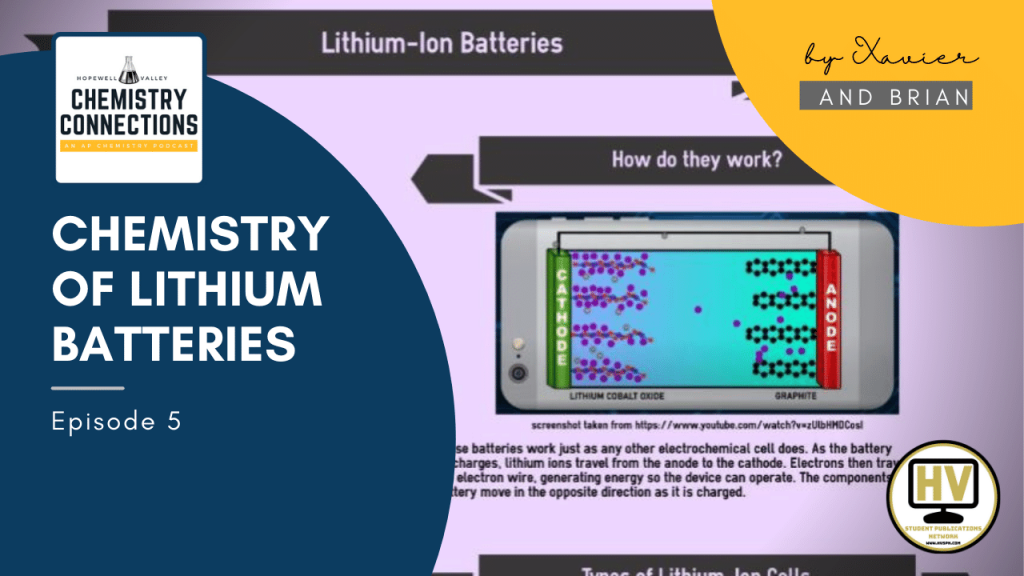Chemistry of Lithium Ion Batteries

Chemistry Connections
Episode #5
Welcome to Chemistry Connections, my name is Brian Shen/Xavier Park and we are your host for episode 5 called The Chemistry of Lithium-ion Batteries. Today we will be discussing how lithium-ion batteries work, and how their environment affects them.
Segment 1: Introduction to Lithium-ion Batteries
Introduce the episode topic
Include definitions, vocabulary, interesting background information and context
Lithium Ion batteries are used in numerous applications from mobile devices to electric cars. They are currently the highest energy density batteries that are mass produced. In the past, Nickel Metal Hydride or Lead Acid batteries were common for any application requiring rechargeable batteries.
Sounds like we’re dealing with some complex topics here. Let’s explain them a bit in case our listeners are getting overwhelmed.
Segment 2: The Chemistry Behind Lithium-ion Batteries
Have a natural transition into an example… no need to say “segment 2”
Provide detailed explanations of the chemistry that is related to your topic.
While these batteries might seem complicated, the chemistry behind them is still based on the same concepts of electrochemistry. It’s just like an electrochemical cell with an anode and a cathode.
Lithium ions travel back and forth between the anode and cathode as the battery charges and discharges.
The cell also consists of an electrolyte solution. This solution is usually a solution of lithium salts and a solvent.
Is there any reason why they use lithium ions instead of other elements?
Since lithium ions are rather small compared to other elements, a lot of lithium can be stored in a small area which is why Li-ion batteries have such high energy densities compared to lead-acid batteries or nickel MH batteries, both larger elements.
And there’s different types of lithium-ion batteries as well, right?
(LiFePO4 batteries)
- Known for extremely high charge and discharge rates due to their pool passed ion storage
- Many more cycles compared to other lithium batteries
- Used in some car batteries since they are able to provide the huge amount of current needed to start a car
They’re clearly quite practical, but one of the most frustrating things is when you go outside on a cold winter day and your phone battery instantly drops 20%.
Yeah, why is that?
Because the electrochemical cells rely on chemical reactions to function, it is only natural that the cold weather would hinder their ability to work.
It limits the ability for the forward reactions to take place, therefore reducing the amount of electrons transferring from the anode to the cathode.
For similar reasons, this is why your phone’s battery may seem to be restored when it eventually warms up.
Once it reaches a certain point, the chemical reactions resume taking place, thus continuing the functionality of the battery.
So now that we know that heat can help the batteries function, can heat also be detrimental?
Yes, actually. These electrochemical cells are sealed, so they are more or less closed systems in some ways. There are therefore pressures inside the cell, and we know from chemistry that heat introduced into a system tends to increase pressure because particle movement becomes more chaotic.
Oh, that’s a bit concerning, because batteries heat up by themselves during use. That explains why batteries have limits on how much current can flow through them. Usually higher capacity batteries have higher internal resistance while high current cells generally lower internal resistance. When the same amount of current is being drawn from a cell, the cell with lower IR will generate less heat and see a lower voltage drop.
Segment 3: Personal Connections
What interested you in this topic? Why is it important? Anything else you’d like to share.
Now I have to ask, why do you know all of this?
I am interested in this topic because I build my own Li-ion battery packs using individual 18650 cells. I’ve been able to create a battery inside of an ammo can that can store 2.7 kWh (1000w load for 2.7 hours). I’ve also taken cells apart to find many layers. Now I finally understand what each of those layers do and the chemistry behind it.
Thank you for listening to this episode of Chemistry Connections. For more student-ran podcasts and digital content, make sure that you visit www.hvspn.com.
Sources:
https://www.science.org.au/curious/technology-future/lithium-ion-batteries
https://www.livescience.com/61334-batteries-die-cold-weather.html
Music Credits
Warm Nights by @LakeyInspired

